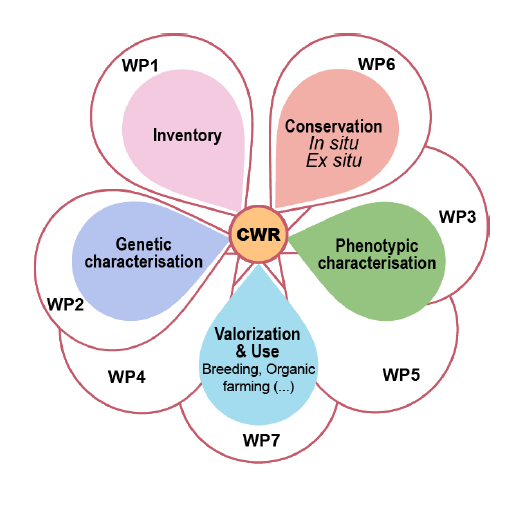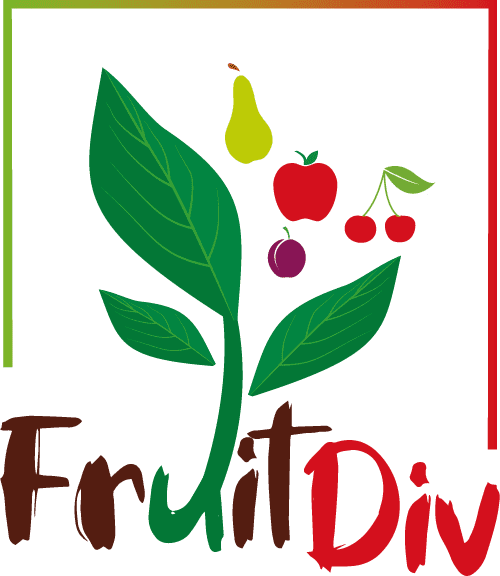
The FruitDiv project is structured through eight different work packages. The main objectives of each one are outlined here below.
| WP1: CWR inventory and knowledge WP leader: AUTH Co-leader: IBRC | WP2: CWR genotypic characterisation WP leader: CNRS Co-leader: INRAE | WP3: Ex-situ phenotyping CWRs for traits important for different end users and resilient fruit production systems WP leader: INRAE Co-leader: ELGO-DIMITER |
| The objectives of WP1 include to: i) perform a complete inventory and network mapping of public and private ex-situ CWR collections; ii) develop the sampling design and sample plant material from the in-situ CWR populations; iii) perform phenotyping of in-situ CWR populations and individuals; iv) assess the leaf and root level microbiodiversity associated to CWR populations through metabarcoding; and v) detail and monitor all the legal, technical and ethical procedures for germplasm sampling and use. | WP2 activities aim to: i) define core-collections for each genus and species to conserve the widest genetic diversity by planting ex-situ collections multi-sites, EU-wide; ii) identify key population(s) preserved in-situ, and specify species status; iii) produce a robust genotypic dataset along with methodology and metadata for further genetics analyses; and iv) provide a comparative view of species and population diversities and structures of fruit tree CWR. | The focus of WP3 is to: i) contribute to the ex situ conservation of CWRs and establish a long-term experimental design for an efficient phenotyping allowing to disentangle genetic effects and GxE interactions in CWRs; ii) characterise the phenotypic variability in CWRs populations and existing core-collections; and iii) produce phenotypic data along with metadata formatted for WP4 that will be used for genetic analyses in WP5. |
| WP4: Integrated multiomics resources for data analysis, visualisation and sharing WP leader: FEM Co-leader: NIB | WP5: Introduction of CWR in Multiomics-based methods to integrate CWR in pre-breeding programs WP leader: CRAG Co-leader: Uppsala University | WP6: Valuation and plans for sustainable conservation of CWRs WP leader: GIS Co-leader: Arcadia International |
| WP4 activities aim to: i) construct pangenomes for different fruit tree taxa; ii) generate easy-access CWR web services, including germplasm, phenotypic and genomic resources; and iii) link the available data to prior knowledge with knowledge graphs. | The objectives of WP5 are to: i) understand and overcome inter-specific barriers for a better use of CWR in breeding; ii) increase the knowledge and unravel the genetic basis of valuable traits; iii) develop, multiply, and share high- quality genomic resources to promote the use of CWR; and iv) design and implement innovative genomic and phenomic tools adapted to breeding schemes with CWR. | The focus of WP6 activities is to i) assess and increase the valuation of CWR; ii) identify the main elements of an optimum management strategy to preserve as much fruit CWR genetic diversity as possible; iii) avoid inbreeding and gene flow with related crop species; and iv) build on the socio-cultural, economic and environmental values and services that CWR provide. |
| WP7: Communication, dissemination and exploitation of results WP leader: Arcadia International | WP8: Project management WP leader: INRAE |
| The objectives of WP7 include to: i) ensure communication, dissemination and optimal uptake of FruitDiv results; ii) organise a series of dedicated tools, communicating and disseminating information with all concerned actors (from crop wild relative experts down to the general public); iii) set-up a detailed mapping of project stakeholders; iv) develop capacity building tools and organise trainings for these stakeholders; and v) engage stakeholders (input) from Day 1 of the project with a dedicated communication and dissemination strategy (output) to fully exploit the results of the research. | WP8 objectives comprise: i) at the strategic level: to ensure that the project reaches its objectives and address all unexpected situations, be these scientific, technological, environmental or societal; ii) at the operational level: to put in place the procedures and tools needed so that the project progresses in conformity with the Grant Agreement, the Consortium Agreement and the work plan with regard to overall progress, milestones, deliverables, and planned resources; and iii) at the organisational level: to organise general project meetings and collaborative work, prepare project reports and ensure efficient internal communication amongst partners. |
